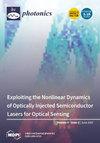Single-Source VLCP System Based on Solar Cell Array Receiver and Right-Angled Tetrahedron Trilateration VLP (RATT-VLP) Algorithm
IF 2.1
4区 物理与天体物理
Q2 OPTICS
引用次数: 0
Abstract
A significant deployment limitation for visible light communication and positioning (VLCP) systems in energy- and light-source-restricted scenarios is the reliance of photodetectors (PDs) on external power supplies, compromising sustainability and complicating receiver charging. Solar cells (SCs), capable of harvesting and converting environmental light into electrical energy, offer a promising alternative. Consequently, we first propose an indoor VLCP system that utilizes an SC array as the receiver, alongside a right-angled tetrahedron trilateration visible light positioning (RATT-VLP) algorithm based on a single light source and multiple receivers. The proposed system uses an SC array in place of PDs, utilizing binary phase shift keying (BPSK) signals for simultaneous communication and positioning. In experiments, we verified the system’s error-free communication rate of 1.21 kbps and average positioning error of 3.40 cm in a 30 cm × 30 cm area, indicating that the system can simultaneously satisfy low-speed communication and accurate positioning applications. This provides a viable foundation for further research on SC-based VLCP systems, facilitating potential applications in environments like underwater wireless communication, positioning, and storage tank inspection.基于太阳能电池阵列接收器和直角四面体三天平 VLP(RATT-VLP)算法的单源 VLCP 系统
在能源和光源受限的情况下,可见光通信和定位(VLCP)系统在部署上的一个重大限制是光电探测器(PD)对外部电源的依赖,这不仅影响了系统的可持续性,也使接收器充电变得更加复杂。太阳能电池(SC)能够收集环境光并将其转化为电能,是一种很有前途的替代方案。因此,我们首先提出了一种室内 VLCP 系统,该系统利用太阳能电池阵列作为接收器,并采用基于单光源和多接收器的直角四面体三面定位可见光定位(RATT-VLP)算法。拟议的系统使用 SC 阵列代替 PD,利用二进制相移键控(BPSK)信号同时进行通信和定位。在实验中,我们验证了该系统在 30 cm × 30 cm 区域内的无差错通信速率为 1.21 kbps,平均定位误差为 3.40 cm,这表明该系统可同时满足低速通信和精确定位应用。这为进一步研究基于 SC 的 VLCP 系统提供了可行的基础,促进了在水下无线通信、定位和储罐检测等环境中的潜在应用。
本文章由计算机程序翻译,如有差异,请以英文原文为准。
求助全文
约1分钟内获得全文
求助全文
来源期刊

Photonics
Physics and Astronomy-Instrumentation
CiteScore
2.60
自引率
20.80%
发文量
817
审稿时长
8 weeks
期刊介绍:
Photonics (ISSN 2304-6732) aims at a fast turn around time for peer-reviewing manuscripts and producing accepted articles. The online-only and open access nature of the journal will allow for a speedy and wide circulation of your research as well as review articles. We aim at establishing Photonics as a leading venue for publishing high impact fundamental research but also applications of optics and photonics. The journal particularly welcomes both theoretical (simulation) and experimental research. Our aim is to encourage scientists to publish their experimental and theoretical results in as much detail as possible. There is no restriction on the length of the papers. The full experimental details must be provided so that the results can be reproduced. Electronic files and software regarding the full details of the calculation and experimental procedure, if unable to be published in a normal way, can be deposited as supplementary material.
 求助内容:
求助内容: 应助结果提醒方式:
应助结果提醒方式:


